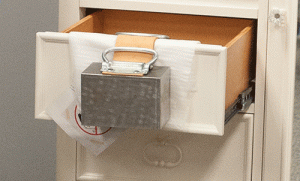After settling a claim on behalf of their client whose son was fatally injured in a furniture tip-over incident at home, Leesfield & Partners attorneys filed a lawsuit against the entities behind the safety standards that the furniture industry lives by. American Home Furnishings Alliance (AHFA) represents approximately 230 furniture manufacturers and distributors, and over 120 suppliers to the furniture industry worldwide. American Society for Testing and Materials (ASTM) has 30,000 members worldwide overseeing more than 12,500 product safety and technical standards. The Furniture Safety Subcommittee within ASTM oversees the furniture stability standard, F2057-19.
In 2017, Meghan DeLong retained Leesfield & Partners to file a wrongful death lawsuit following the death of her 2-year old son, Conner, in a furniture tip-over incident. In their testing, our experts discovered that the dresser in question would tip-over 100% of the time they replicated a young child climbing atop the very piece of furniture. Inversely, the defendant manufacturer argued that the dresser’s design satisfied ASTM’s voluntary standards, including tip-over prevention standards, and that their experts’ testing results showed 0% occurrence of the dresser tipping over. How could these two findings be true?
The answer is found in the ASTM standards themselves. The voluntary standard ASTM F2057-14, Standard Safety Specification Clothing Storage Units, establishes requirements for free-standing clothing storage units, (CSU) such as dressers, chests, and armoires, in the United States, and is intended to minimize the hazards associated with tipover. In practice however, the testing methods implemented by the furniture industry and approved by ASTM F2057-14, do not take into account dozens of crucial human factors that, if taken into account, render most pieces of furniture dangerous, thus defective.
 The most flagrant inadequacies of ASTM’s test methods (as depicted in the photo on the right) are as follows:
The most flagrant inadequacies of ASTM’s test methods (as depicted in the photo on the right) are as follows:
- Empty dresser and open all drawers or pullout shelves to the outstop (or 66% of their operational sliding length);
- Empty dresser and open one drawer to the outstop (or 66% of its operational sliding length). All other drawers and doors not undergoing testing shall be in the closed position. Then gradually apply test weights (50 lbs) over the front of each drawer.
In both tests above, the piece of furniture must be “empty”. Why? Does the average consumer purchase clothing storage units, such as a dresser, to specifically not store any clothing in them? NO. Logic dictates that it is more likely than not to find clothes in a dresser inside a home, than an empty dresser inside a home.
For test #2, ASTM calls for the gradual application of test weights while one drawer is open at a time. Why gradual? Do children who climb atop dressers by using gradual propelling force? NO. In order to propel themselves vertically up, a child may exert an impulsive force downward, which by nature are not gradually applied, especially at a young age where most children exert jerking forces with their lower extremities.
Also for test #2, you must keep all drawers closed except the one being tested. Are children who climb atop dressers careful enough to close each drawer after they’ve used it as a step ladder? NO. Once again, a child who climbs does not look back to carefully make sure they only use one drawer at a time while climbing. The reality is, as they climb a dresser, a child will continually look up and drawers will stay open, creating even more forward weight, increasing the risk of the dresser tipping over.
Click here to read additional shortcomings of ASTM’s test method.
In our case, the defective drawer passed ASTM’s test, but in the real world, it failed every single time. The situation is now clear: The furniture industry designs products based on ASTM’s voluntary standards that are inadequate because inadequately tested against. Then, manufacturers hide behind such standards when a specific piece is involved in an incident such as the one that took Conner’s life. This untenable and infuriating situation has resulted in over one million ER visits and over 600 fatalities.
To learn more about tip-over incidents and safety standards, call us at 305-854-4900.
 Florida Injury Lawyer Blawg
Florida Injury Lawyer Blawg


